By Mike Houck, January 27 2016
 One of the points I raise consistently in presentations to groups regionally and nationally regarding our urban greenspaces initiative is how we have fashioned our own successes around “lessons learned.” Among the many “lessons learned” are: power of the outside expert, it’s all about relationships, and use good models. This trifecta was essential to launching the first regional greenspaces bond measure through Metro in the early 1990s, and more recently in raising our game to the next level through creation of The Intertwine Alliance.
One of the points I raise consistently in presentations to groups regionally and nationally regarding our urban greenspaces initiative is how we have fashioned our own successes around “lessons learned.” Among the many “lessons learned” are: power of the outside expert, it’s all about relationships, and use good models. This trifecta was essential to launching the first regional greenspaces bond measure through Metro in the early 1990s, and more recently in raising our game to the next level through creation of The Intertwine Alliance.
In 1988 a friend of mine, Janet Cobb, had just spearheaded the East Bay Regional Park District’s (EBRPD) $222-million AA Measure to fund acquisition and management of the District’s natural areas program. Sensing the District would be a great model for our own efforts to establish a similar effort in the Portland-Vancouver region, Metro’s Mel Huie, Joe Porasky in PSU’s geography department, wildlife and wetland consultants Esther Lev and Lynn Sharp, and I worked with Cobb to set up two trips to the District so we could show an on-the-ground example of what we considered to be the nation’s most successful natural areas-focused regional park district.
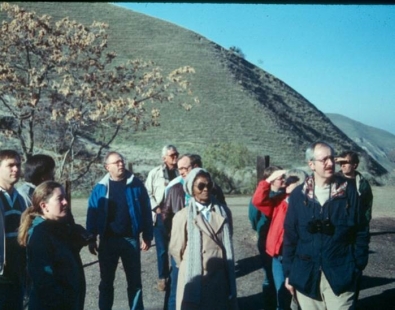 For the first trip, in May of 1989, we invited local elected officials from Metro and around the region, along with local park professionals and park advocates, to join us on a two-day bus tour and visits with District staff. We wanted to learn how their system was conceived, how they managed their relationships with local park providers and elected officials, and to observe the diversity of natural areas and trails they owned and managed. We enjoyed the experience so much that we took a second trip.
For the first trip, in May of 1989, we invited local elected officials from Metro and around the region, along with local park professionals and park advocates, to join us on a two-day bus tour and visits with District staff. We wanted to learn how their system was conceived, how they managed their relationships with local park providers and elected officials, and to observe the diversity of natural areas and trails they owned and managed. We enjoyed the experience so much that we took a second trip.
Those two excursions were, in my opinion, one of the most important catalysts toward building the political will and esprit de corps, and in developing our own template for success in subsequent efforts to create the bi-state Greenspaces Master Plan. They led to us eventually passing two successful bond measures totaling $363 million, with which Metro has acquired 17,000 acres of natural areas and local providers have added to their natural-area holdings.
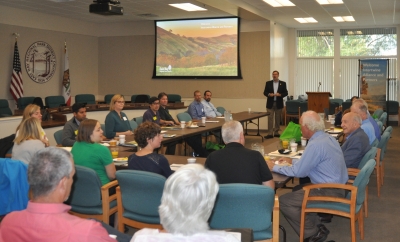 In addition to establishing and strengthening personal and professional relationships among the participants, and bringing home a national model from which to fashion our own vision for a regional system of parks, trails and natural areas, the single most significant “lesson learned” from EBRPD was the 75-25 percent regional-local split that formed the basis for the District’s 1988 AA Bond Measure. Their brilliant revenue-sharing strategy was predicated on the fact that East Bay had carved out a unique role within Contra Costa and Alameda counties, two of the most urban counties in the United States. Aside from a few anomalies where the District has inherited more active recreation facilities, such as Tilden Regional Park, the District specializes in protecting, restoring and managing natural areas and trails. Local providers who focus exclusively on active recreation and developed parks were allocated 25 percent of the $225 AA bond. That formula holds true to this day, including in the 2008 $500 million Measure WW, which required a 2/3 “super majority” vote. (It received 72-percent approval.) The measure’s stated goals were to “restore urban creeks; protect wildlife; purchase open space, wetlands and bay shoreline; and acquire, develop and improve both local and regional parks, trails, and recreational facilities.”
In addition to establishing and strengthening personal and professional relationships among the participants, and bringing home a national model from which to fashion our own vision for a regional system of parks, trails and natural areas, the single most significant “lesson learned” from EBRPD was the 75-25 percent regional-local split that formed the basis for the District’s 1988 AA Bond Measure. Their brilliant revenue-sharing strategy was predicated on the fact that East Bay had carved out a unique role within Contra Costa and Alameda counties, two of the most urban counties in the United States. Aside from a few anomalies where the District has inherited more active recreation facilities, such as Tilden Regional Park, the District specializes in protecting, restoring and managing natural areas and trails. Local providers who focus exclusively on active recreation and developed parks were allocated 25 percent of the $225 AA bond. That formula holds true to this day, including in the 2008 $500 million Measure WW, which required a 2/3 “super majority” vote. (It received 72-percent approval.) The measure’s stated goals were to “restore urban creeks; protect wildlife; purchase open space, wetlands and bay shoreline; and acquire, develop and improve both local and regional parks, trails, and recreational facilities.”
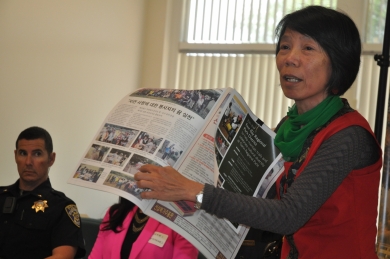 The most important “take home” lessons from EBRPD were: develop a local share; build relationships with local park providers and elected officials; and the need for leadership from the top. In my opinion, while we had achieved the first two, our 1992 bond measure effort failed due to lack of the latter requisite. That changed in 1995 when the Metro Council, with Councilor Patricia McCaig taking the lead, went to the region’s voters for a $135.6 million bond measure. And again in 2006 when Metro President David Bragdon led the charge for another $227.4 million bond measure to acquire, protect and management natural areas throughout the Portland metropolitan region. With their 25-percent share, each of the local park providers also increased their own park, trail and natural-area holdings.
The most important “take home” lessons from EBRPD were: develop a local share; build relationships with local park providers and elected officials; and the need for leadership from the top. In my opinion, while we had achieved the first two, our 1992 bond measure effort failed due to lack of the latter requisite. That changed in 1995 when the Metro Council, with Councilor Patricia McCaig taking the lead, went to the region’s voters for a $135.6 million bond measure. And again in 2006 when Metro President David Bragdon led the charge for another $227.4 million bond measure to acquire, protect and management natural areas throughout the Portland metropolitan region. With their 25-percent share, each of the local park providers also increased their own park, trail and natural-area holdings.
Those campaigns, I believe, succeeded in large part to the inspiration we drew from the East Bay Regional Park District, generally, and to Janet Cobb, who came to our region repeatedly to cheer us on and provide invaluable advice to our 1992 campaign.
East Bay Tour, Redux
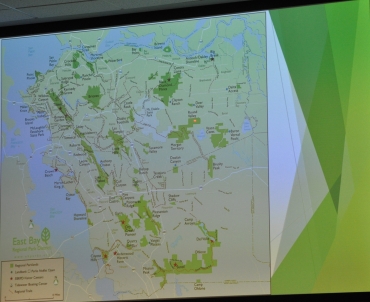 East Bay Regional Park District continues to be what I consider the platinum-level park and natural area district in the country. It owns more than 120,000 acres of land, including regional parks, recreation areas, wilderness, shorelines, preserves and land-banked areas; 1,250 miles of trails within park areas; and numerous interpretive and education centers, in one of the nation’s most populous urban environments.
East Bay Regional Park District continues to be what I consider the platinum-level park and natural area district in the country. It owns more than 120,000 acres of land, including regional parks, recreation areas, wilderness, shorelines, preserves and land-banked areas; 1,250 miles of trails within park areas; and numerous interpretive and education centers, in one of the nation’s most populous urban environments.
No wonder then that Huie, Metro’s regional trail planner, militated for several years for a third visit to East Bay, arguing that a new contingent of elected officials, park advocates and park professionals might benefit as much as we had in 1990.
Acting on behalf of The Intertwine Alliance and its partners, Metro Parks and Nature Director Kathleen Brennan-Hunter, Huie and other Metro staff, along with Intertwine Alliance Executive Director Mike Wetter and I, requested a two-day visit that would include a day with District staff and a day in the field for a sampling of their facilities.
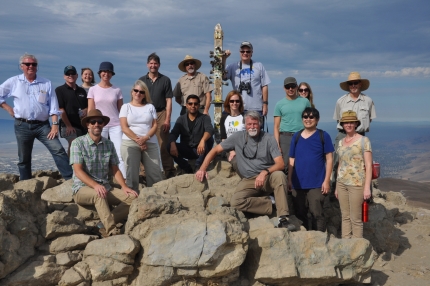 On Oct. 13, 2015, our metro-area contingent* gathered at the Clarion Hotel in Oakland, and the following morning drove to the District’s Oakland headquarters for an all-day visit. District staffers and board members briefed us on an array of programs we had specified interest in, including: an overview of the District’s history, current operations and organizational structure; the Master Plan; the Foundation; the Healthy Parks/Healthy People Bay Area program; the Stay Healthy In Nature Every day program (SHINE); increasing diversity among park users and employees; youth employment programs; and promoting and maintaining collaboration with local jurisdictions, including funding and branding.
On Oct. 13, 2015, our metro-area contingent* gathered at the Clarion Hotel in Oakland, and the following morning drove to the District’s Oakland headquarters for an all-day visit. District staffers and board members briefed us on an array of programs we had specified interest in, including: an overview of the District’s history, current operations and organizational structure; the Master Plan; the Foundation; the Healthy Parks/Healthy People Bay Area program; the Stay Healthy In Nature Every day program (SHINE); increasing diversity among park users and employees; youth employment programs; and promoting and maintaining collaboration with local jurisdictions, including funding and branding.
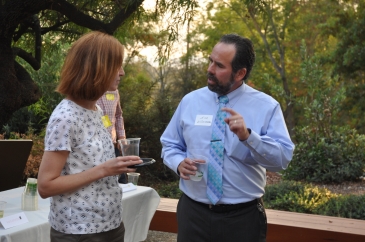 In the afternoon we learned about the District’s high-level visioning and priority setting; the strategies that led to a “super majority” 77-percent approval of the 2008 $500 million Measure WW; securing operations and management funding; biodiversity and endangered species planning; and mountain bike user conflict planning in the context of commitment to natural resource protection.
In the afternoon we learned about the District’s high-level visioning and priority setting; the strategies that led to a “super majority” 77-percent approval of the 2008 $500 million Measure WW; securing operations and management funding; biodiversity and endangered species planning; and mountain bike user conflict planning in the context of commitment to natural resource protection.
It’s impossible to fully describe all of these programs** in this brief summary, but suffice it to say the District continued to inspire everyone who attended the tour.
Highlights I took away include:
- Health-Nature: The strong connection the District has established with local health providers provides a powerful affirmation that The Intertwine Alliance’s health-and-nature focus is not only a worthy undertaking but provides us with some specifics that we should implement.
- Youth Employment and Minority Recruitment: EBRPD staff does not stop at simply recruiting minority and underrepresented youth as interns, but tracks them over several years and eventually recruits a significant number to become District staff. Amazingly, staff work hard to place successful interns in other jobs in the Bay Area if they do not apply for jobs within the District. Swim instructors track kids from age 6 months to 16 years to encourage involvement in seasonal jobs with the District.
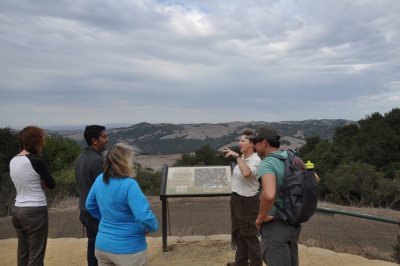 Parks-Transit: The District’s trail network has become integrated with BART and the East Bay’s transit system in what EBRPD District General Manager Robert Doyle described as a transition from “People and Parks” to “People to Transit” – with an exponential increase in paved off-street trails.
Parks-Transit: The District’s trail network has become integrated with BART and the East Bay’s transit system in what EBRPD District General Manager Robert Doyle described as a transition from “People and Parks” to “People to Transit” – with an exponential increase in paved off-street trails.
- System Planning and Wildlife Corridors: There has been an intentional shift over the past two decades from management of individual natural areas to an interconnected system of parks, natural areas and wildlife corridors.
- Connectivity and Endangered Species: After passage of 1988's AA Measure, the District transitioned to addressing ecological connectivity and responding to endangered species protection. They have created a model Habitat Conservation Plan for 14,000 acres in Contra Costa County.
- Public Support: The District enjoys more than 80 percent approval by constituents, with 77 percent indicating the District’s contribution to quality of life as a major reason for that level of approval.
- Land Use: The District monitors development in all 33 cities and both counties to analyze development proposals, so that it can partner when issues affect their holdings.
- Political Relationships: Perhaps the singular lesson we have to learn is the District’s aggressive, strategic and long-term relationship-building with elected officials at every level of government. District staff, board members and advocates have been assigned to virtually every elected official, including the Congressional delegation, within the District’s boundary.
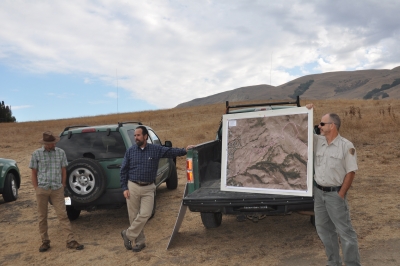 Field Tour: As in 1989, we toured several EBRPD facilities to discuss on-the-ground management issues. At 3,000-acre Mission Peak Regional Preserve, we hiked a pretty stiff uphill to the popular elevation marker and had lunch at Point Isabel Regional Shoreline on San Francisco Bay (the only park in the system where dogs are allowed off-leash and under voice command). After lunch, we visited sites where the District has been engaged in vegetation management to establish fuel breaks for wildfire management in the hills above Berkeley. We finished off the day at the Tilden Regional Park nature center for an end-of-tour meeting between District staff and board members and our now-tired but super-inspired contingent.
Field Tour: As in 1989, we toured several EBRPD facilities to discuss on-the-ground management issues. At 3,000-acre Mission Peak Regional Preserve, we hiked a pretty stiff uphill to the popular elevation marker and had lunch at Point Isabel Regional Shoreline on San Francisco Bay (the only park in the system where dogs are allowed off-leash and under voice command). After lunch, we visited sites where the District has been engaged in vegetation management to establish fuel breaks for wildfire management in the hills above Berkeley. We finished off the day at the Tilden Regional Park nature center for an end-of-tour meeting between District staff and board members and our now-tired but super-inspired contingent.
Bottom line: The District’s efforts to provide us with information, social time with staff and board members, and field tours was over the top. We finished off the evening with a pledge to bring EBRPD staff and board to visit The Intertwine region -- with their only caveat being we have to plan the visit to coincide with one of our microbrew festivals.
Institute at the Golden Gate/Fort Mason
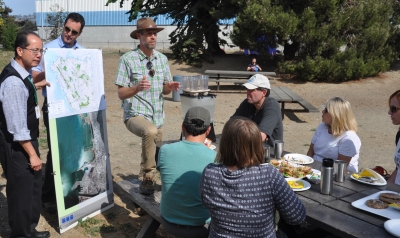 Metro’s Brennan-Hunter set up a separate trip to visit the Golden Gate National Parks Conservancy at Fort Mason to meet with staff at the Institute at the Golden Gate to discuss their partnership with the Healthy Parks/Healthy People program and their work to address climate change.
Metro’s Brennan-Hunter set up a separate trip to visit the Golden Gate National Parks Conservancy at Fort Mason to meet with staff at the Institute at the Golden Gate to discuss their partnership with the Healthy Parks/Healthy People program and their work to address climate change.
The Institute, which started as a think tank, is now looking at new demographics of the Bay region and the role parks might play with regard to social change through three programs: sustainable foods, climate change, and working with the National Park Service to increase relevancy of parks to a broader audience.
Most relevant to The Intertwine Alliance is their collaborative work with EBRPD’s Healthy Parks/Healthy People Bay Area, a Collective Impact model which mirrors The Intertwine Alliance’s work with the same model.
* GreenWorks, PC: Mike Faha and Robin Craig
Metro: Kathleen Brennan-Hunter, Mel Huie, Dan Moeller, Justin Paterson, Laura Odom, Ina Zucker and Hillary Wilton
Tualatin Hills Park and Recreation District: John Griffiths and Doug Menke
The Intertwine Alliance: Mike Wetter
Urban Greenspaces Institute: Mike Houck
Vive Northwest: Jorge Guzman
** The full range of programs are described on EBRPD’s website.

 Mike Houck directs the
Mike Houck directs the
Add new comment